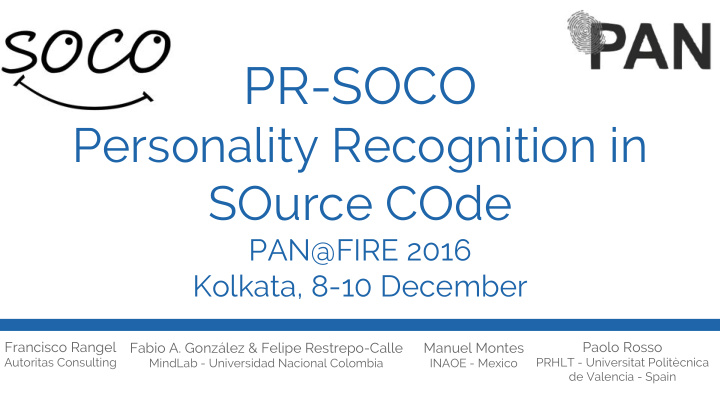



PR-SOCO Personality Recognition in SOurce COde PAN@FIRE 2016 Kolkata, 8-10 December Francisco Rangel Paolo Rosso Fabio A. González & Felipe Restrepo-Calle Manuel Montes Autoritas Consulting PRHLT - Universitat Politècnica MindLab - Universidad Nacional Colombia INAOE - Mexico de Valencia - Spain
PAN@FIRE’16 Introduction Author profiling aims at identifying personal traits such as age, gender, native language or personality traits from writings. This is crucial for: - Marketing - Security PR-SOCO - Forensics 2
PAN@FIRE’16 Task goal To predict Personality Traits from Source Codes . This is crucial for: - Human resources management for IT departments. PR-SOCO 3
PAN@FIRE’16 Corpus ● Java programs by computer science students at Universidad Nacional de Colombia ● Allowed: ○ Multipe uploads of the same code ○ Errors (compiler output, debug information, source codes in other languages such as Python…) SOURCE CODES 2,492 AUTHORS 70 TRAINING TEST PR-SOCO 49 21
PAN@FIRE’16 Evaluation measures Two complementary measures per trait: ● Root Mean Squared Error to measure the goodness of the approaches. ● Pearson Product-Moment Correlation to measure the random chance effect. PR-SOCO 5
PAN@FIRE’16 Republic of Korea 48 runs 11 participants 9 accepted papers PR-SOCO 7 countries 6
PAN@FIRE’16 Approaches - Features Bag of Words, word n-gams or char n-grams Besumich, Gimenez, Besumich Word vectors (skip-thought encoding) Lee Byte streams Doval ToneAnalyzed Montejo Code structure (ANTLR syntax) Bilan, Castellanos Specific features related to coding style Bilan, Delair, Gimenez, HHU, Kumar, Uaemex - Length of the program, length of the classes... - Average length of variable names, class names… - Number of methods per class, ... - Frequency of comments and length - Identation, code layout, … Halstead metrics (software engineering metrics) Castellanos PR-SOCO + 2 baselines: char 3-grams and the observed mean. 7
PAN@FIRE’16 Approaches - Methods Logistic regression Lee, Gimenez Lasso regression Besumich Support vector regression Castellanos, Delair, Uaemex Extra trees regression Castellanos Gaussian processes Delair M5, M5 rules Delair Random trees Delair Neural networks Doval, Uaemex Linear regression HHU, Kumar PR-SOCO Nearest neighbour HHU, Uaemex Symbolic regression Uaemex 8
PAN@FIRE’16 RMSE distribution Too many outliers with poor performance... PR-SOCO 9
PAN@FIRE’16 RMSE distribution (without outliers) The best results (state of the art) The lowest sparsity PR-SOCO 10
PAN@FIRE’16 Pearson distribution ● Results much similar than for RMSE ● The average value is poor (lower than 0.3) PR-SOCO 11
PR-SOCO PAN@FIRE’16 Neuroticism 12
PR-SOCO PAN@FIRE’16 Extroversion 13
PR-SOCO PAN@FIRE’16 Openness 14
PR-SOCO PAN@FIRE’16 Agreableness 15
PAN@FIRE’16 Conscientiousness PR-SOCO 16
PAN@FIRE’16 Conclusions The task aimed at identifying big five personality traits from Java source codes. ● ● There have been 11 participants sending 48 runs. Two complementary measures were used: ● ○ RMSE : overall score of the performance. Pearson Product-Moment Correlation : whether the performance is due to ○ random chance. Wrt. results : ● ○ Quite similar in terms of Pearson for all traits. Higher differences wrt. RMSE : the best results for openness (6.95) ○ ● Several different features : Generic (word and character n-grams) vs. specific (obtained by parsing the code, ○ analysing its structure, style or comments) Generic features obtained competitive results in terms of RMSE ... ○ ○ … but with lower Pearson values. They seemed to be less robust. ○ PR-SOCO ● Baselines obtained low RMSE with low Pearson -> this highlights the need of using both complementary measures. 17
PAN@FIRE’16 On behalf of the PR-SOCO task organisers: Thank you very much for participating PR-SOCO and hope to see you next year!! 18
Recommend
More recommend